Spotting Concealed Weapons

Whether you work in law enforcement, security or just want to be aware of those around you who might be armed, these basic indicators can help you spot those armed and provide tips on better ways to carry your own weapon. The way the person moves, adjusts themselves, walks, sits, reaches, or even stands can all inadvertently draw attention to the fact they - or you - are carrying.
I’ve worked with firearms for more than twenty-five years starting at CIA, then a major private security firm in Afghanistan, the U.S. Air Marshal program and then the U.S. Department of State as an instructor in weapons and tactics for both groups. I’ve carried everything from handguns to assault rifles, both openly and in a concealed fashion, and thought that passing along some lessons learned might be helpful.
Simple things can expose your weapon. For example, you carry a weapon and need to reach for something on a high shelf…you use your non-firing hand. If you carry anywhere along the waist, your shirt or jacket will be stretched, exposing your gun. If you kneel to pick up something from the floor, you’ll do it without bending at the waist. Instead, go straight up and down using your legs because bending will print the weapon against the fabric of your clothing, exposing its shape to alert observers.
Let’s start with the three basic mistakes commonly made by folks not used to carrying every day - Touching, Adjusting in-line, and Looking at (or in) available reflections.
Touching is reaching with a hand, inside of their elbow or forearm to make contact with the weapon. Maybe they don’t carry regularly and aren’t completely comfortable with it or maybe they just like the reassurance, but it’s a telltale that a weapon might be somewhere near.
Adjusting in-line happens when the armed person doesn’t trust their holster and constantly moves the weapon, the belt or the pants. Folks not used to carrying will do this quite a bit.
Looking at themselves in reflections occurs when they try to catch a glimpse of themselves to see whether their weapon is visible. Again a mistake made by novices.
Now let’s break things down a bit more…
Arm-guard, body shifting and bracing.
When moving, armed folks might have a slightly clipped arm swing on the gun-side. The forearm on the gun side will tend to stay close to the body, guarding the weapon to keep it from moving as much as possible.
When approached from the front, a person carrying concealed might shift his gun side away from the approaching person, blading off a bit and perhaps pull his gun side arm into his body, protecting the weapon subconsciously.
When running – whether to cross a street or simply get out of the rain — someone carrying a weapon will often press their gun side arm into the weapon, bracing it from moving during the run. If wearing a suit or jacket they’ll do this to keep the garment from blowing open, exposing the weapon.
Now drill down and look at specific types of carry positions…
Outside the pants.

Called Outside the Waist Belt (OWB), the simplest thing is to look for a bulge around the waistline where the gun is carried…or it’s a really big phone.
Next look for a belt line that is higher than normal. Many who carry multiple magazines and a weapon, or a heavy gun such as a full-size .45, will raise their belt-line to make up for dragging down of the gear on their belt. Related to the belt-line is to watch for an uneven belt-line. If the belt is uneven on the left or the right it could be the weapon dragging down that side of the belt.
Also look for people wearing clothes uncommon for the weather. Is it a clear summer day and the guy’s wearing a windbreaker? Might be to hide a weapon. Jackets, sweaters and other clothing not in-season suggest the wearer might be hiding something underneath. As always, look for those touching an area of their body. Many times, someone carrying will do this without even realizing it, giving away their carry location.
Inside the pants.
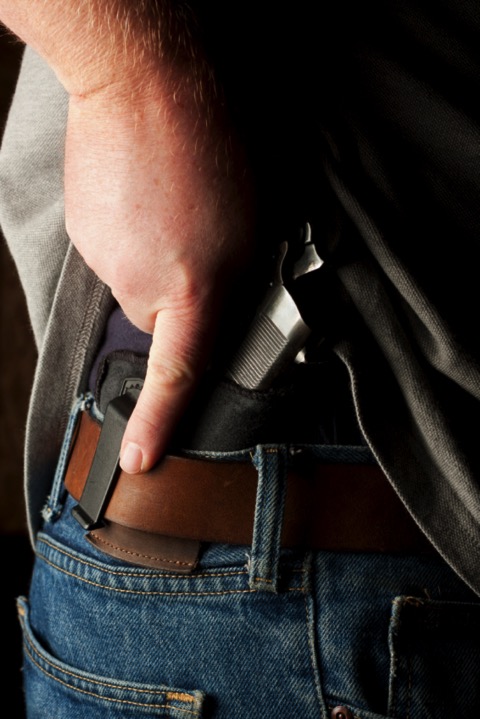
Whether carried on the right or left hip, in front (appendix carry) or in the small of the back, look for the easy things to spot like a bulge, subconscious touching or the uneven waistline. But one thing that indicates it’s carried Inside the Waist Belt (IWB) is a mismatch of the color of the belt versus that of the holster. Sometimes a tan holster clip will be visible against a black belt, or some other mismatched color combination that shows up on the waistline.
IWB rigs can also be uncomfortable compared to OWB holsters, causing the wearer to shift in chairs or favor one leg more than another to shift weight and relieve gun pressure against the body. In addition, shirts pulled over the belt-line are necessary to hide the weapon, just like OWB wearers.
In the Pocket
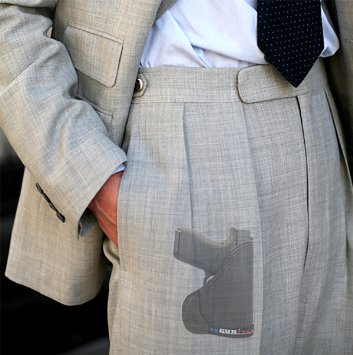
As with the carry options discussed above, weapons create bulges, so look for bulging pockets. They also have weight, which drags the pocket down so watch for pockets with an uneven mouth. Weapons also have a distinctive shape and, when pressed against material, that shape is visible – that’s the printing mentioned in the beginning of this article – so watch for printing of the pocket. As with the other methods of carry, be aware of those constantly touching a certain area of their body, too.
Ankle
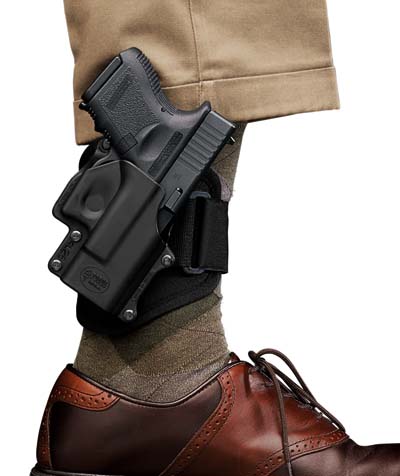
Some people choose to carry a weapon down by their shoe in an ankle rig or in a hasty hiding spot like a strong sock. Look at the inseam of the pants (a person's inseam is the length of the inner leg, from the top of the thigh to the ankle) for one that is longer than normal. Similarly, look for indications that one leg is larger in the calf area that the other or that their pace is shorter. The weapon has weight and taking long strides can cause it to bounce, slide or rock back and forth, so shorter strides are often taken to mitigate that risk. Look for the person who’s nervous about crossing their legs when sitting down, or who’s constantly adjusting the crease of their trousers on just one leg. One final thing to look for is a sock that bunches up on top of the shoe caused by the ankle holster pressing down on them.
Shoulder holster
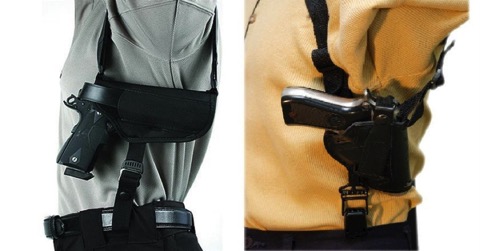
If carrying IWB or OWB, the jacket or shirt doesn’t necessarily have to be untucked for the shooter to access the weapon. They can simply lift the garment. But that’s not the case if carrying in a shoulder rig – the jacket or shirt has to be untucked and open, otherwise risking hanging up the weapon when drawing it for use.
There is also an unnatural body movement associated with carrying a weapon under the armpit. The wearer might favor one side of the body more than the other or one arm might be slightly further from the body than the other. Touching is also an indicator here, but with the strong hand doing the job.
Quick Carry

This style of carry is just placing the weapon in the waistline without a holster, much like Magnum used to do on TV. Whether in the front, side or rear of the pants, the shirt or jacket will be untucked and lots of touching and adjusting will be going on, as well as lots of bathroom breaks for the armed individual to adjust in private.
Fanny Packs
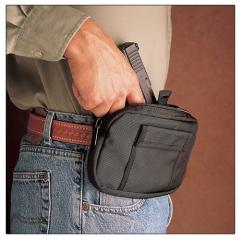
These bags were fairly popular about ten years ago and some still use them, though most are black or tan and their design screams “GUN!” to most folks unless they’re pink with rainbows. In general, those with guns inside are kept closer than normal to the body by cinching the waist belt tightly. It’s required to have it secured that way in order to operate the zipper pull quickly to access the weapon. Also look for the front of the bag to have more downward pull on it, as the weight of the gun drags the bag down.
Backpack

Often the backpack concealing a weapon will have one different colored zipper pull for the pocket hiding the weapon. You might also notice the wearer constantly adjusting their position to keep others from standing behind them. They also never put it down.
Briefcase

Like the backpack, the wearer will never let it go and there might be a safety tab or pull cord for quick access.
Wardrobe thoughts
Finally, if you carry a concealed weapon for work or safety, remember the first part of the term…concealed. You are hiding it for a reason. One is that the law requires it if you hold a concealed carry permit, unless you have open carry laws in your state. But another is to prevent being targeted by bad guys because you carry a weapon. Imagine you’re in a bank or store that’s being held up and you’re obviously armed…you’re the first target.
So buy a holster you can trust and wear without checking your weapon constantly, allows for seasonally appropriate clothing and doesn’t affect your stride. Lastly, if you walk around like the poster child for all things tactical, you’re going to stick out – you’ll be “that guy (or girl).” You don’t need everything that 5.11 or Blackhawk makes, or at least you don’t need to wear it all at one time.

(no we have no idea who this is)
Simple things can expose your weapon. For example, you carry a weapon and need to reach for something on a high shelf…you use your non-firing hand. If you carry anywhere along the waist, your shirt or jacket will be stretched, exposing your gun. If you kneel to pick up something from the floor, you’ll do it without bending at the waist. Instead, go straight up and down using your legs because bending will print the weapon against the fabric of your clothing, exposing its shape to alert observers.
Let’s start with the three basic mistakes commonly made by folks not used to carrying every day - Touching, Adjusting in-line, and Looking at (or in) available reflections.
Touching is reaching with a hand, inside of their elbow or forearm to make contact with the weapon. Maybe they don’t carry regularly and aren’t completely comfortable with it or maybe they just like the reassurance, but it’s a telltale that a weapon might be somewhere near.
Adjusting in-line happens when the armed person doesn’t trust their holster and constantly moves the weapon, the belt or the pants. Folks not used to carrying will do this quite a bit.
Looking at themselves in reflections occurs when they try to catch a glimpse of themselves to see whether their weapon is visible. Again a mistake made by novices.
Now let’s break things down a bit more…
Arm-guard, body shifting and bracing.
When moving, armed folks might have a slightly clipped arm swing on the gun-side. The forearm on the gun side will tend to stay close to the body, guarding the weapon to keep it from moving as much as possible.
When approached from the front, a person carrying concealed might shift his gun side away from the approaching person, blading off a bit and perhaps pull his gun side arm into his body, protecting the weapon subconsciously.
When running – whether to cross a street or simply get out of the rain — someone carrying a weapon will often press their gun side arm into the weapon, bracing it from moving during the run. If wearing a suit or jacket they’ll do this to keep the garment from blowing open, exposing the weapon.
Now drill down and look at specific types of carry positions…
Outside the pants.

Called Outside the Waist Belt (OWB), the simplest thing is to look for a bulge around the waistline where the gun is carried…or it’s a really big phone.
Next look for a belt line that is higher than normal. Many who carry multiple magazines and a weapon, or a heavy gun such as a full-size .45, will raise their belt-line to make up for dragging down of the gear on their belt. Related to the belt-line is to watch for an uneven belt-line. If the belt is uneven on the left or the right it could be the weapon dragging down that side of the belt.
Also look for people wearing clothes uncommon for the weather. Is it a clear summer day and the guy’s wearing a windbreaker? Might be to hide a weapon. Jackets, sweaters and other clothing not in-season suggest the wearer might be hiding something underneath. As always, look for those touching an area of their body. Many times, someone carrying will do this without even realizing it, giving away their carry location.
Inside the pants.

Whether carried on the right or left hip, in front (appendix carry) or in the small of the back, look for the easy things to spot like a bulge, subconscious touching or the uneven waistline. But one thing that indicates it’s carried Inside the Waist Belt (IWB) is a mismatch of the color of the belt versus that of the holster. Sometimes a tan holster clip will be visible against a black belt, or some other mismatched color combination that shows up on the waistline.
IWB rigs can also be uncomfortable compared to OWB holsters, causing the wearer to shift in chairs or favor one leg more than another to shift weight and relieve gun pressure against the body. In addition, shirts pulled over the belt-line are necessary to hide the weapon, just like OWB wearers.
In the Pocket

As with the carry options discussed above, weapons create bulges, so look for bulging pockets. They also have weight, which drags the pocket down so watch for pockets with an uneven mouth. Weapons also have a distinctive shape and, when pressed against material, that shape is visible – that’s the printing mentioned in the beginning of this article – so watch for printing of the pocket. As with the other methods of carry, be aware of those constantly touching a certain area of their body, too.
Ankle

Some people choose to carry a weapon down by their shoe in an ankle rig or in a hasty hiding spot like a strong sock. Look at the inseam of the pants (a person's inseam is the length of the inner leg, from the top of the thigh to the ankle) for one that is longer than normal. Similarly, look for indications that one leg is larger in the calf area that the other or that their pace is shorter. The weapon has weight and taking long strides can cause it to bounce, slide or rock back and forth, so shorter strides are often taken to mitigate that risk. Look for the person who’s nervous about crossing their legs when sitting down, or who’s constantly adjusting the crease of their trousers on just one leg. One final thing to look for is a sock that bunches up on top of the shoe caused by the ankle holster pressing down on them.
Shoulder holster

If carrying IWB or OWB, the jacket or shirt doesn’t necessarily have to be untucked for the shooter to access the weapon. They can simply lift the garment. But that’s not the case if carrying in a shoulder rig – the jacket or shirt has to be untucked and open, otherwise risking hanging up the weapon when drawing it for use.
There is also an unnatural body movement associated with carrying a weapon under the armpit. The wearer might favor one side of the body more than the other or one arm might be slightly further from the body than the other. Touching is also an indicator here, but with the strong hand doing the job.
Quick Carry

This style of carry is just placing the weapon in the waistline without a holster, much like Magnum used to do on TV. Whether in the front, side or rear of the pants, the shirt or jacket will be untucked and lots of touching and adjusting will be going on, as well as lots of bathroom breaks for the armed individual to adjust in private.
Fanny Packs

These bags were fairly popular about ten years ago and some still use them, though most are black or tan and their design screams “GUN!” to most folks unless they’re pink with rainbows. In general, those with guns inside are kept closer than normal to the body by cinching the waist belt tightly. It’s required to have it secured that way in order to operate the zipper pull quickly to access the weapon. Also look for the front of the bag to have more downward pull on it, as the weight of the gun drags the bag down.
Backpack

Often the backpack concealing a weapon will have one different colored zipper pull for the pocket hiding the weapon. You might also notice the wearer constantly adjusting their position to keep others from standing behind them. They also never put it down.
Briefcase

Like the backpack, the wearer will never let it go and there might be a safety tab or pull cord for quick access.
Wardrobe thoughts
Finally, if you carry a concealed weapon for work or safety, remember the first part of the term…concealed. You are hiding it for a reason. One is that the law requires it if you hold a concealed carry permit, unless you have open carry laws in your state. But another is to prevent being targeted by bad guys because you carry a weapon. Imagine you’re in a bank or store that’s being held up and you’re obviously armed…you’re the first target.
So buy a holster you can trust and wear without checking your weapon constantly, allows for seasonally appropriate clothing and doesn’t affect your stride. Lastly, if you walk around like the poster child for all things tactical, you’re going to stick out – you’ll be “that guy (or girl).” You don’t need everything that 5.11 or Blackhawk makes, or at least you don’t need to wear it all at one time.

(no we have no idea who this is)